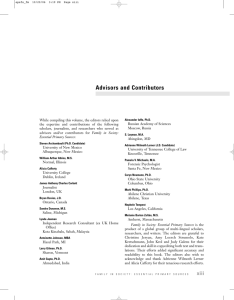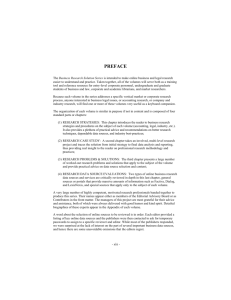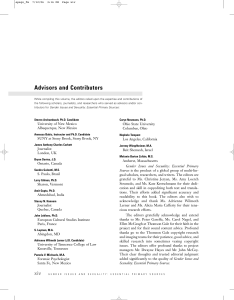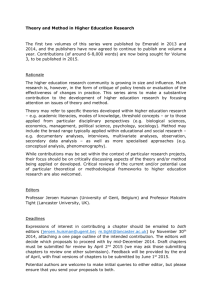quality in wikipedia
advertisement
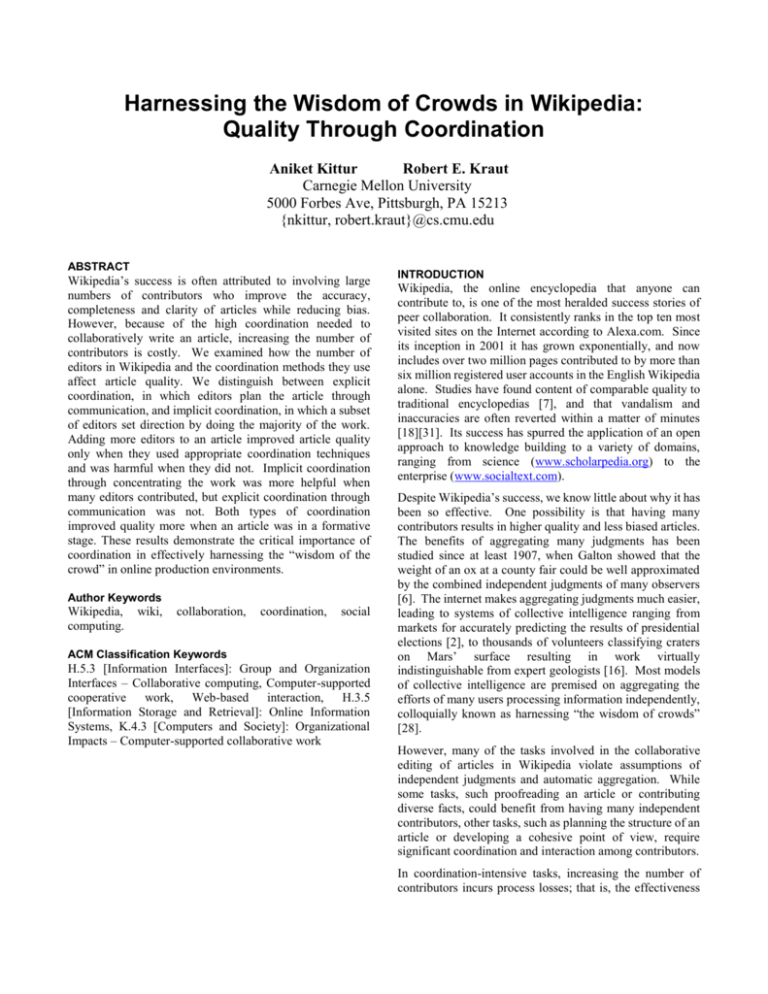
Harnessing the Wisdom of Crowds in Wikipedia:
Quality Through Coordination
Aniket Kittur
Robert E. Kraut
Carnegie Mellon University
5000 Forbes Ave, Pittsburgh, PA 15213
{nkittur, robert.kraut}@cs.cmu.edu
ABSTRACT
Wikipedia’s success is often attributed to involving large
numbers of contributors who improve the accuracy,
completeness and clarity of articles while reducing bias.
However, because of the high coordination needed to
collaboratively write an article, increasing the number of
contributors is costly. We examined how the number of
editors in Wikipedia and the coordination methods they use
affect article quality. We distinguish between explicit
coordination, in which editors plan the article through
communication, and implicit coordination, in which a subset
of editors set direction by doing the majority of the work.
Adding more editors to an article improved article quality
only when they used appropriate coordination techniques
and was harmful when they did not. Implicit coordination
through concentrating the work was more helpful when
many editors contributed, but explicit coordination through
communication was not. Both types of coordination
improved quality more when an article was in a formative
stage. These results demonstrate the critical importance of
coordination in effectively harnessing the “wisdom of the
crowd” in online production environments.
Author Keywords
Wikipedia,
computing.
wiki,
collaboration,
coordination,
social
ACM Classification Keywords
H.5.3 [Information Interfaces]: Group and Organization
Interfaces – Collaborative computing, Computer-supported
cooperative work, Web-based interaction, H.3.5
[Information Storage and Retrieval]: Online Information
Systems, K.4.3 [Computers and Society]: Organizational
Impacts – Computer-supported collaborative work
INTRODUCTION
Wikipedia, the online encyclopedia that anyone can
contribute to, is one of the most heralded success stories of
peer collaboration. It consistently ranks in the top ten most
visited sites on the Internet according to Alexa.com. Since
its inception in 2001 it has grown exponentially, and now
includes over two million pages contributed to by more than
six million registered user accounts in the English Wikipedia
alone. Studies have found content of comparable quality to
traditional encyclopedias [7], and that vandalism and
inaccuracies are often reverted within a matter of minutes
[18][31]. Its success has spurred the application of an open
approach to knowledge building to a variety of domains,
ranging from science (www.scholarpedia.org) to the
enterprise (www.socialtext.com).
Despite Wikipedia’s success, we know little about why it has
been so effective. One possibility is that having many
contributors results in higher quality and less biased articles.
The benefits of aggregating many judgments has been
studied since at least 1907, when Galton showed that the
weight of an ox at a county fair could be well approximated
by the combined independent judgments of many observers
[6]. The internet makes aggregating judgments much easier,
leading to systems of collective intelligence ranging from
markets for accurately predicting the results of presidential
elections [2], to thousands of volunteers classifying craters
on Mars’ surface resulting in work virtually
indistinguishable from expert geologists [16]. Most models
of collective intelligence are premised on aggregating the
efforts of many users processing information independently,
colloquially known as harnessing “the wisdom of crowds”
[28].
However, many of the tasks involved in the collaborative
editing of articles in Wikipedia violate assumptions of
independent judgments and automatic aggregation. While
some tasks, such proofreading an article or contributing
diverse facts, could benefit from having many independent
contributors, other tasks, such as planning the structure of an
article or developing a cohesive point of view, require
significant coordination and interaction among contributors.
In coordination-intensive tasks, increasing the number of
contributors incurs process losses; that is, the effectiveness
of the group will be lower than what the members are
theoretically capable of [26]. Adding more heads often has
diminishing returns due to increased coordination
requirements or decreased member motivation, especially
for complex tasks or those with strong interdependencies
[10][25]. In the extreme, adding more people may have
negative consequences, as Brooks Law states in the domain
of software projects: “Adding manpower to a late software
project makes it later” [4].
There is significant evidence that collaboratively writing
articles in Wikipedia requires a high degree of coordination
between users. Contributors to a page work to achieve
consensus on a variety of issues, such as what the article will
include and what it won’t; which points of view will be
represented and to what degree; wording and prose; and its
structure and organization. Coordination costs are a
substantial and growing proportion of all work done in WP:
nearly 40% of all edits in Wikipedia involve indirect work
such as communication, consensus building, and
development of policies and procedures [18]. Much of this
work takes place on dedicated discussion pages where
changes are often discussed before being implemented in the
article itself [32]. Thus coordination factors may play an
important role in Wikipedia’s success, separate from the
influence of the number of contributors.
Empirical evidence regarding the effects of increasing
numbers of contributors on the quality of Wikipedia content
is scarce. The most definitive study to date has demonstrated
that high quality articles in Wikipedia (“featured” articles)
have substantially more editors involved than do run-of-the
mill, non-featured articles, even after controlling for article
popularity [34]. However, the correlational nature of the
analyses used leaves open the possibility of reverse
causation (i.e., higher quality articles may attract additional
editors instead of many editors producing higher quality
articles). Furthermore, the coarse metric of quality used
(featured vs. non-featured) meant that few high-quality
articles were sampled (fewer than 2000 featured vs. more
than 2,000,000 non-featured) and the ones that were sampled
went through a highly stringent, peer review process not
representative of most articles in Wikipedia. These factors
potentially limit the generality of the results.
The present research uses longitudinal data to examine the
degree to which the number of editors contributing to an
article in Wikipedia affects its quality and more specifically,
the conditions under which adding contributors to a
Wikipedia article improves its quality. It shows that the
effectiveness of adding contributors is critically dependent
on the degree and type of coordination those contributors
use, as well as the lifecycle of the article and the
interdependence of the tasks involved in editing it.
COORDINATION AND QUALITY
Coordination is essential to the effective functioning of
groups, and is especially important as those groups grow in
size. Each new editor working on an article in Wikipedia has
the potential to contribute new knowledge with which to
flesh out an article, insight into how the article should be
written and vigilance to discover errors in fact, grammar or
judgment. To harness these contributions, however, they
need to coordinate their efforts on interdependent aspects of
the article, like its structure and stylistic coherence.
Jamie Zawinski, creator of the open-source Mozilla
application, characterized the coordination problem in
groups as: “great things are accomplished by small groups of
people who are driven, who have unity of purpose. The more
people involved, the slower and stupider their union is” [36].
However, there are many ways to effect a “unity of purpose”
in group collaboration. Theories of group coordination
suggest a basic distinction between explicit coordination,
based on direct communication and verbal planning, and
implicit coordination, based on unspoken expectations and
shared mental models of the task to be accomplished
[24][35]. Below we examine evidence of both types of
coordination in Wikipedia.
Explicit coordination
Editors can explicitly coordinate with each other in a number
of ways in Wikipedia. The most commonly used mechanism
for communication is the discussion page, although other
mechanisms such as user talk pages are growing in
importance [18]. The discussion page is a dedicated page
associated with each article that provides a forum for
coordinating changes to the article, discussing policies and
procedures, and eliciting assistance from other editors [32].
Figure 1 shows the topics from the “Glock” article, a typical
discussion page. Discussion topics range from a relatively
superficial (yet heated) debate about the capitalization of the
name (“GLOCK vs. Glock debate”) to more substantive
coordination building consensus around the scope of the
article (in “Misconceptions”, whether certain myths and
misconceptions should be included or excluded). There is
often a complex interplay of coordination between the
discussion page and the article page, with editors proposing
changes to be made to the article page, as well as discussing
changes already made.
otherwise require high coordination between contributors.
One marker of implicit coordination common to all cases is a
few editors doing the lion’s share of the work.
It is important to note that editing concentration is distinct
from the number of editors: articles may have the same
number of editors and even edits but very different
distributions of work. To take an extreme example, an
article with 100 editors and 1000 edits could be dominated
by a single editor making 901 edits with the remaining 99
editors making a single edit each; alternatively, work could
be evenly distributed with each editor making 10 edits.
Figure 1. Topics of the discussion page for the “Glock” article.
To gain insight into the overall impact of explicit
coordination activity we conducted an analysis of the
proportion of discussion page activity to article activity for
all articles in Wikipedia. The “proportion of coordination
activity” in Figure 2 refers the ratio of discussion to article
edits for each week of an article’s life. This analysis shows
an increase in the importance of explicit coordination over
the years as the number of contributors has grown.
Furthermore, explicit coordination is especially important
early in an article’s lifecycle: more than half of all edits in the
first week of an article are made to the discussion page rather
than the content of the article.
Implicit coordination
Proportion coordination activity
Editors can also implicitly coordinate in Wikipedia, either by
playing a leadership role in setting the direction and scope of
an article, providing a framework to integrate the work of
less involved editors, or by taking on tasks that would
1
0.9
0.8
0.7
0.6
0.5
0.4
0.3
0.2
0.1
0
2001-3
2004
2005
2006
-10
10
30
Weeks since first edit of page
50
Figure 2. Proportion of coordination to production activity
for the first 50 weeks of an article’s life across all Wikipedia
articles. Colors correspond to different years; the size of
each circle is proportional to the log of the number of edits.
Examples of implicit coordination can be found in the
“Music of Italy” article. As shown in Figure 4, the user
TUF-KAT does a large proportion of the work in the article
during the first few months of the article’s life. An
examination of her first edits reveals the creation of the
initial structure of the article (see Figure 3A) that is refined
by herself and others to set the scope and direction of the
content (Figure 3B). This structure remains substantively
constant, with the addition of few sections of content, for the
duration of the period marked as B in Figure 4. Note that
during this period the proportion of work actually done by
TUF-KAT is relatively low, indicating that others are
continuing to follow the structure that she initiated.
Concentrating work in fewer individuals also decreases
coordination requirements by reducing the need for explicit
communication: highly interdependent tasks that would
require significant coordination between editors -- such as
making an article stylistically coherent -- may be efficiently
executed by a single individual. Continuing to use the
“Music of Italy” article as an example, Figure 4 shows that
the user Jeffmatt does a large proportion of all of the editing
within the period of January to July 2006 (period C). His
contributions involve a major reorganization and expansion
of the article’s structure and contents, which can be seen by
the change in topic structure from Figure 3C to Figure 3D.
These organizational changes were not made in a vacuum;
after proposing and executing the changes Jeffmatt received
explicit feedback from other highly involved members,
notably TUF-KAT. However, this explicit coordination was
largely limited to a few highly involved contributors rather
than the general community. By concentrating work in a
few individuals, the reorganization task could be
accomplished while minimizing the overhead that would be
required if a large group of editors was involved.
To quantify the concentration of work in an article we use
the gini coefficient, a commonly used metric for measuring
the skew of a distribution.
Articles with edits are
concentrated in few individuals will have gini coefficients
close to one, while articles with edits evenly distributed
across all editors will have coefficients close to zero.
Interactions with age and group size
Both explicit and implicit coordination are likely to be
especially valuable when articles are at a formative stage,
when the tasks involved are more likely to be
interdependent.
Editors in Wikipedia often use the
discussion page to explicitly negotiate the scope and
structure of an article and agree on standards to be used [32].
Additionally, early or heavy contributors may act as leaders
by implicitly setting the direction, scope, and structure of an
article, creating a framework for less involved editors to
effectively fill in; indeed, Wikipedia directs users who create
new articles to provide “enough information for [other]
editors to expand upon” [10].
Explicit and implicit coordination may differentially interact
with increasing group size. Explicit coordination is
especially valuable in small groups engaged in complex
tasks that require a high degree of synchronization between
members [35]. As the size of the group grows, however, the
amount of communication needed to effectively coordinate
increases super-linearly, leading to process loss,
inefficiency, and a reliance on pre-determined plans
[26][30]. This suggests that increasing communication
between editors may not be an efficient coordination
mechanism as groups grow in size.
Conversely, implicit coordination involves the tacit
development of a shared mental model among group
members, allowing them to more efficiently aggregate their
Figure 4. User activity for the “Music of Italy” article.
efforts towards a common goal [24]. Since implicit
coordination avoids the overhead of discussion, it may scale
with group size better than explicit coordination. Implicit
coordination through fewer editors doing more of the work
also reduces the total amount of interpersonal coordination
needed, as interdependent tasks can be accomplished by
single individuals.
QUALITY IN WIKIPEDIA
To assess article quality we took advantage of Wikipedia’s
article assessment project, which in preparation for creating
Figure 3. Evolution of topic structure for the “Music of Italy” article. Letters above the topic structures correspond to the beginning
of the periods in Figure 4: creation of the article (A), the end of TUF-KAT’s initial editing (B), the beginning of Jeffmatt’s editing
(C), and the end of Jeffmatt’s editing (D).
an off-line release of the encyclopedia has organized the
evaluation of over 900,000 articles into six gradations of
quality, ranging from “stub” to “featured-article” status [14].
Concrete guidelines for assessing each class include factors
such as how well written, factually accurate, verifiable,
comprehensive, neutral, and stable the article is [15]. For
example, a stub is described as an article which is “very short
… or a rough collection of information”. A B-class article
“usually [has] a majority of the material needed for a
comprehensive article. Nonetheless, it has some gaps or
missing elements or references, needs editing for language
usage or clarity, balance of content, or contains other policy
problems.” An A-class article “provides a well-written,
reasonably clear and complete description of the topic” with
appropriate length, well-written introduction, good
illustration, and information cited from reputable sources.
To check on the external validity of the community ratings
we conducted a survey among non-Wikipedians. The
guidelines on assessment grading in Wikipedia [12] provides
an example page for each assessment quality level, including
“Coffee table book”, “Munich air disaster”, “Real analysis”,
“International space station”, “Durian”, and “Agatha
Christie: And then there were none.” For each of these pages
we used Amazon’s Mechanical Turk market (mturk.com) to
collect user’s ratings of article quality. Articles were rated
on a 7-point Likert scale ranging from “Very low quality” to
“Very high quality”. We employed the procedure detailed in
[19] of asking verifiable questions (including the number of
sections, images, and references) before asking for the
subjective quality evaluation, which has been shown to
promote valid responding.
We collected 120 ratings of the 6 example articles, each
representing a different community-assessed quality level.
Responses were checked for validity of verifiable questions
and sufficient time on task (>30 seconds). Only one
response was excluded due to failing to satisfy the above
requirements. Thirty-four users participated in the study,
with all but one reporting that they were not expert users of
Wikipedia. A Spearman rank correlation of article ratings
from external raters with Wikipedia community assessments
was positive and highly significant (r(5) = .54, p < .001),
indicating substantial agreement between external and
Wikipedia ratings.
DATA
The two datasets used in the analyses were provided by the
MediaWiki foundation. For editing information we used a
dataset from October 2007 that included only the metadata
of the revisions (e.g., who edited which page, which
category a page is in, etc.) but not the full text. As the large
size of the Wikipedia dataset has made full text dumps
difficult for the MediaWiki foundation to create, archive,
and publish, a slightly older full text dump was used that
included the full text of all Wikipedia revisions up to April
2007 (approximately 160 million).
We sampled up to 75,000 articles in each quality level
(which included all articles for the top three quality levels)
from the October 2007 dataset. Articles that were simply
lists of other articles were excluded, as these were
unrepresentative of the typical Wikipedia article. We split
the data for each article into two six-month intervals, from
April 2006 to April 2007. Table 1 shows the distribution of
the maximum quality for articles in the sample.1
For each interval and for each article we computed the
article’s age in months since its first edit, the number of
article editors who made at least one edit during the interval,
explicit and implicit coordination metrics, and the article’s
assessed quality at the beginning and end of the interval. To
quantify explicit coordination we used the number of edits
made to the discussion page.
To quantify implicit
coordination we used the gini coefficient, which provides a
measure of the concentration of edits within the distribution
of editors. Because age, the number of article editors, and
the number of discussion edits all have highly skewed
distributions, we transformed these measures by taking their
log to the base 2 to make the distributions more normal.
We computed the quality at the beginning and end of each
interval. The primary way that the Wikipedia community
assesses article quality is by placing a template on the
discussion page of an article. The template used to indicate
quality also automatically places an article into the relevant
quality class.
To gather longitudinal information on changes in article
quality over time we need to know the date on which a given
assessment template was added to an article. Unfortunately,
the Wikipedia database does not directly store the date on
which a specific template was added to specific article. To
acquire this information the Hadoop distributed file system
[8] was used to analyze the full text of every revision for all
articles in Wikipedia (approximately 1.6 TiB). The highest
level quality assessment template prior to the time period
was used to determine the starting quality of the article, and
the highest level assessment template within the time period
was used to determine the end quality. Table 1 shows the
highest quality rating achieved by the 147,360 articles in the
sample. Of these, only 23,619 had both a beginning and
ending quality assessment for any time period; these are the
Maximum
N of
quality
Articles
Not rated
36,239
Stub
27,633
Start
51,983
B-Class
27,263
GA-Class
1,657
1
Due to the difference
in time between the two
datasets used, some
A-Class
1,132
articles identifiedFeatured
as a given quality level in 1,453
the October dataset had
not been rated as such by the end of the April dataset. Thus
Totalwere
articles
although 75k articles
sampled for147,360
each quality level, some
levels
had 1.
fewer
articles that
reached by
thatmaximum
quality level
by April
Table
Distribution
of articles
quality.
2007.
Descriptive Statistics
Quality change
Initial Quality
Article Age
# Article Editors
Editor Concentration
# Talk Editors
# Talk Edits
Mean Median Std
.09
.00
.55
2.36
2.00 1.14
25.90
21.73 17.41
48.31
11.00 108.73
.26
.25
.18
6.00
2.00 16.28
15.84
2.00 88.21
Correlations
#
Editor
Quality Initial Article Article Concen- # Talk
change Quality Age Editors tration Editors
-.20
.00
.08
.20
.14
.17
.29
.43
.27
.47
.45
.51
.21
.41
.38
.61
.78
.76
.52
.57
.97
Table 2. Descriptive statistics before log transformations and correlations after log transformation.
articles used for the primary analyses reported below.
APPROACH
We initially conducted a similar cross-sectional analysis as
in [34] but using multiple levels of the quality assessment
scale. Consistent with [34], the total number of editors who
ever worked on an article was moderately correlated with the
quality of the article (r=.40, p < .001) and this association
remained when one controls for the age of the article and the
number of page views the article receives (partial correlation
= .22, p <.001).
However, these cross-sectional correlations provide little
insight into the influence of the number of editors on article
quality because of problems with reverse causation (high
quality articles attracting more editors rather than
participation by more editors improving article quality) and
uncontrolled confounding factors like article importance.
Using a longitudinal approach enables stronger causal claims
than would be possible with cross-sectional correlations and
avoids problems with reverse causation. By examining
changes in the quality of the same articles over time,
longitudinal analyses also control for time-invariant
unobserved qualities of the articles, like their topic,
importance, and availability of secondary sources.
Our goal is to examine how the number of contributors to an
article and the differing coordination techniques they use
results in changes in the quality of the article during a given
time period. To do so, we use the lagged, multiple regression
approach for modeling change recommended by Cohen et al
[5]. We predict changes in article quality between two time
periods (QualityTn-QualityTn-1) from the number of editors
involved and the coordination techniques they used during
this interval, holding constant the article quality at the first
time period (QualityTn -1). This procedure removes the
potential influence of the initial quality on the relationship
between the predictors and changes in quality, controls for
regression towards the mean, and controls for unobserved,
stable article characteristics.
Because only a subset of Wikipedia articles have been
evaluated for quality, and the same factors, such as the
number of editors working on an article, can influence both
whether it will be evaluated and its quality, it is necessary to
control for selection biases when modeling changes in
quality. To do so, we used the Heckman 2-step selection
model [9], which uses logistic regression to generate a
derived variable predicting whether the article will receive at
least one quality evaluation during the study interval. This
propensity to be evaluated is then used as a control variable
in the second stage of the analysis predicting changes in
article quality.
When modeling an article’s propensity to be evaluated for
quality, we included in the first stage of the Heckman
analysis the cumulative number of edits the article had prior
to the start of the observation period along with the article
age, the number of editors working on the article during the
period, the editor concentration, and the number of talk edits
it received. A robustness check, in which we added the
number of page views an article received, led to similar
results.
Of the 23,619 articles in the sample, we could compute
change scores across two time periods for 890 articles and a
change scores across one time period for 22,729 articles. To
deal with the non-independence in the data, with some
articles having change scores in more than one time interval,
we used a robust technique that adjusts the standard errors
for intra-article correlation.
RESULTS
Table 2 presents the means, medians and standard deviations
of the variables used in the analysis (before the log
transformation) and correlations among variables (after the
log transformations) for the 23,619 articles that had both a
beginning and end quality assessment in at least one interval.
One interesting observation from this table is that during
each 6-month period, many more contributors actually edit
the article (median=11) than participate in discussions on the
article’s discussion page (median=2). This observation
suggests that even explicit coordination via discussion has an
implicit component to it: planning is done by a small subset
of contributors.
Table 3 presents results from the second stage of the
Heckman regression, predicting changes in article quality
from initial quality, article age, the number of editors
working on an article and the coordination techniques they
used. To reduce the multi-colinearity between main effect
and interactions in regression analyses, we centered all
independent variables [1]. Thus, the coefficients presented in
Table 3 should be interpreted as the effect of a unit increase
in an independent variables (i.e., increasing initial quality by
one class, increasing concentration from completely even to
completely concentrated, and doubling an article’s age in
months, the number of editors involved, and the number of
edits on its talk page) when other variables are at their mean
level.
Model 1 in Table 3 is the base model, predicting change in
article quality over a 6-month period from the article’s initial
quality, its age, and the number of editors who worked on it
during that period. On average articles improved .44 quality
classes over a six month period when all other variables were
at their mean level. An article’s initial quality was inversely
associated with changes in its quality (i.e., initially poor
articles got better and high quality articles got worse). This
is a result of both floor and ceiling effects (stubs can’t get
worse and featured articles can’t get better), higher standards
in Wikipedia over time, and regression towards the mean. In
addition, a project’s age was associated with a small decline
in its quality, again reflecting more stringent standards in
Wikipedia over time.
More interestingly, the number of editors working on an
article during a 6-month period was positively associated
with increases in article quality during that period, even
holding constant article age and initial quality. Each
doubling in the number of editors was associated with a
increase in .05 quality classes.
Model 2 adds implicit coordination (i.e., editor
concentration) and its interactions with the number of
editors, article age and initial article quality to the model.
When concentration is added to the model the influence of
the number of editors no longer predicts increases in quality,
while concentration does. Articles in which the work is
Intercept
Initial Quality
Article Age
# Editors
Editor Concentration
Editors X Concentration
Quality X Concentration
Age X Concentration
# Talk Edits
Editors X Talk
Quality X Talk
Age X Talk
Coef.
.442
-.149
-.024
.053
Model 1
# Editors
SE
.025
.005
.004
.002
P
***
***
***
***
highly concentrated in a small subset of editors improve in
quality much more than do articles where the work is evenly
divided.
Strikingly, there was a significant positive interaction
between the degree of concentration and the number of
editors. As shown in Figure 5, increasing the number of
editors improved quality when work was highly
concentrated (i.e., above the median), but detrimental when
work was more evenly distributed (i.e., below the median).
In addition, Model 2 also shows negative interactions
between concentration and the initial quality of an article
(see Figure 7) and it age. Both interactions indicate that the
benefits from implicit coordination are greater early in the
article’s life history, when it is still a ‘stub’, the least
complete article. During this phase, when editors must
outline the article’s structure, having a subset of them do the
direction setting leads to greater increases in quality.
Model 3 adds explicit coordination (i.e., talk edits) and its
interactions with the number of editors, article age, and
initial article quality to the base model. Articles with more
talk page communication improve in quality more than
articles with little communication. As in Model 2, when talk
edits are added to the base model the number of editors no
longer predicts increases in quality, while communication
does. The significant negative interactions between talk
page communication and both article age and initial quality
indicate that, like implicit coordination, explicit coordination
is most beneficial early in an article’s lifecycle.
In contrast to the case for implicit coordination, the
interaction between explicit coordination and the number of
editors is significantly negative (see Figure 6). This
indicates that although more communication is helpful when
there are few editors, the benefits of communication decline
when there as the number of editors involved grows.
Finally, Model 4 combines the effects and interactions of the
number of editors, implicit coordination, and explicit
coordination. The results for this combined model are
Model 2
Editor Concentration
Coef.
SE
P
.329
.031
***
-.138
.005
***
-.005
.004
.003
.003
.791
.041
***
.248
.017
***
-.236
.032
***
-.066
.027
*
Model 3
Talk Edits
Coef.
SE
.362
.028
-.151
.005
-.017
.004
-.005
.003
.113
-.003
-.012
-.009
.005
.001
.003
.003
P
***
***
***
***
*
***
**
Coef.
.304
-.146
-.006
-.020
.600
.216
-.222
-.041
.087
-.010
-.001
-.003
Model 4
All
SE
.033
.005
.004
.003
.038
.020
.035
.028
.004
.002
.003
.003
P
***
***
***
***
***
***
***
***
Table 3. Nested lagged regression analysis of the number of editors, coordination metrics (editor concentration and talk edits), and
article lifecycle on change in article quality.
Note: *** p<.001, ** p<.01, * p<.05
largely consistent with the models looking at the effects of
implicit and explicit communication separately. However,
articles and periods in which a few editors do most of the
work are also ones in which these editors talk to each other
on the article talk page. As seen in Table 2, the correlation
between article concentration and discussion page edits is
.57, making it hard to distinguish the independent influence
of each of these coordination techniques.
DISCUSSION
Although some tasks in Wikipedia may be driven by large
numbers of contributors working independently, many other
tasks involve significant coordination between contributors.
The idea that Wikipedia works through the “wisdom of
crowds” is only partially supported in this research. As [34]
showed and we have replicated, articles that have had many
editors working on them are generally better than those with
fewer editors. However, adding more editors to a page
seems to improve its quality only when appropriate
coordination techniques are used. Having more editors work
on an article was associated with increases in article quality
only if the editors used implicit coordination, so that most of
the work was done by a small subset of them, with others
playing a supporting role. Having more editors was not
associated with improvements in article quality when the
work was distributed evenly among editors or when they
used explicit communication on the article talk page to
coordinate. Phrased another way, both implicit coordination,
through editor concentration, and explicit coordination,
through communication, were valuable and were generally
associated with improvement in article quality during the
periods when they were used. However, implicit
coordination was especially valuable with articles and time
periods with many contributors while explicit coordination
was especially valuable in articles and time periods with few
contributors.
Figure 7. Joint influence of initial quality and concentration
of editors on changes in quality.
a structure for the article to which others can contribute. For
example, our data suggest that it is important to have a small
number of contributors setting the direction, structure, and
scope of the article at the beginning of its lifecycle, either
implicitly by actually doing the writing or by explicitly
communicating and coordinating. As the article matures and
coordination requirements ease, tasks may be more
effectively distributed to a larger group of contributors.
In addition, this research has demonstrated that both implicit
and explicit coordination have stronger associations with
increases in article quality early in an article’s lifecycle,
when the article is young and has little content. It is at this
period when tasks are most interdependent and coordination
needs are highest, and the articles creator(s) need to provide
It is no surprise that articles in which the authors
communicate with each other on the article’s talk page
improve more than articles in which editors work
independently, each making a contribution without
discussing changes or getting advice from collaborators.
Interpersonal communication is perhaps the most general
coordination technique available and is the paradigmatic
case of what March and Simon (1958) describe as
"coordination through mutual adjustment," in which
members reveal their current states and intentions and adjust
their behavior to others’ goals and actions [29]. Decades of
research in organizations shows that communication as the
basis for coordination is especially important in tasks that are
highly uncertain, unconstrained, and subject to many
changes (e.g., [17]). These conclusions are consistent with
the observations in the current research that explicit
communication through coordination was most beneficial in
an article’s formative stages, when its structure is highly
unconstrained. In the beginning, no one knows either the
Figure 5. Joint influence of number and concentration of
editors on changes in quality.
Figure 6. Joint influence of number of editors and
communication on changes in quality.
content or structure of an article, but later in its lifecycle the
existing material constrains what new editors can write.
The route by which the concentration of work leads to better
coordination and improvements in quality is less clear. One
possibility is that concentrating editing in fewer editors may
enable a small core of committed contributors to focus on
complex, highly interdependent tasks while allowing
infrequent contributors to add value on simple, stand-alone
tasks or those that benefit from diverse knowledge. For
example, it may be effective for a small core group of users
to work on tasks such as organizing an article and making it
cohesive, whereas tasks with low coordination requirements
-- such as fixing grammar, combating vandalism, or creating
links -- may be more effectively distributed to peripheral
contributors. This strategy may be an efficient way to take
advantage of a large number of contributors while at the
same time minimizing process losses.
A similar participation pattern is found in other successful
peer collaboration projects; for example, in most open
source software (OSS) development projects a relatively
small core of participants do the bulk of the work. However,
this distribution depends upon the nature of the work. In the
Apache server project, a core group of 15 developers
contributed 88% of the new lines of code, but only 66% of
the bug fixes, a less interdependent task [23]. To make an
addendum to Linus’ law about distributed work in OSS, that
“with enough eyeballs, all bugs are shallow”, our results
suggest that while low-coordination tasks such as finding
bugs may benefit from many eyeballs, high-coordination
tasks such as planning new features may best be done by a
small group of core users.
Management implications. Both the public perception and
ideology of Wikipedia is of a free and open environment,
where everyone is equally eligible to contribute. However,
even a free and open environment needs coordination, and
peer-to-peer communication is ineffective if too many
people are involved. Our results show it is highly beneficial
to have people who can set direction and provide a structure
to which others can contribute. In Wikipedia this leadership
group emerges naturally and informally based on editors’
pre-existing interest in the topic, expertise, availability, and
commitment.
However, in other peer production
environments it may be valuable to appoint leaders to
positions of authority and control, and to formally recognize
their roles. This may be especially true for tasks where it is
critical to get things right. For example, in the Linux OSS
project, any change to the code of the central kernel has the
potential to break the entire project, and a structure has
evolved such that a single individual (Linus Torvalds) has
the power to disapprove any change deemed inappropriate.
Similarly, authoritative management techniques are found in
critical knowledge bases such as the Gene Ontology
(www.geneontology.org), in which researchers may propose
new changes but expert curators are responsible for
approving them and maintaining a cohesive structure.
Limitations. The use of longitudinal analyses enables us to
make stronger causal claims than cross-sectional analyses
would allow. However, both types of analyses utilize
correlational data and involve assumptions that can be
challenged. Our analyses take into account individual
differences among articles and quality at the initial time
period. However, the use of longitudinal analyses to assess
causation rests upon an assumption that all the relevant
variables have been measured. It is still possible that some
unmeasured variable that co-varies with quality change and
the use of coordination techniques may account for what
appears to be a direct relationship between use of these
techniques and improvement in quality.
Summary. Wikipedia is both an existence proof and a model
for how complex cognitive tasks with high coordination
requirements can be effectively achieved through distributed
methods. Such methods are already beginning to become
more widely used in both science and the enterprise. Our
results demonstrate the critical importance of coordination in
effectively harnessing the “wisdom of the crowd” in such
environments.
ACKNOWLEDGMENTS
We deeply thank Ed Chi, Bongwon Suh, and Bryan
Pendleton for providing quality assessment data, and John
Riedl and Aaron Halfaker for sharing page view data. Early
directions in this research began while the first author was at
Palo Alto Research Center in the Augmented Social
Cognition group. This work was supported by NSF grants
IIS0729286 and IIS0325049.
REFERENCES
1. Aiken, L. and West, S. Multiple regression: Testing and
interpreting interactions. Sage, CA (1991).
2. Berg, J. E., Forsythe, R., and Rietz, T.A. The Iowa
Electronic Market.
In Blackwell Encyclopedic
Dictionary of Finance, Blackwell, Oxford UK (1997).
3. Benkler, Y. Coase's penguin,or Linux and the nature of
the firm. Yale Law Journal 112 (2002), 367-445.
4. Brooks, F.P. The Mythical Man Month. Addison-Wesley
Longman Publishing Co., Inc. Boston, MA, USA (1975).
5. Cohen, J., Cohen, P., West, S.G. & Aiken, L.S. Applied
multiple regression/correlation analysis for the
behavioral sciences. Lawrence Erlbaum Associates,
Mahwah, New Jersey (2003).
6. Galton, F. Vox populi. Nature, 75 (1907), 7.
7. Giles, G. Internet encyclopaedias go head to head.
Nature, 438 (2005), 900-901.
8. Hadoop Project. http://lucene.apache.org/hadoop/.
9. Heckman, J. Sample selection bias as a specification
error. Econometirica, 47, 1 (1979), 153-162.
10. Hill, G. W. Group versus individual performance. Are n
+ 1 heads better than one? Psychological Bulletin, 91
(1982), 517-539.
11. Hinsz, V. B., Tindale, R. S., and Vollrath, D. A. The
emerging conceptualization of groups as information
processors. Psychological Bulletin, 121, 1 (1997), 43-64.
12. http://en.wikipedia.org/wiki/Category:Wikipedia_1.0_as
sessments
13. http://en.wikipedia.org/wiki/Wikipedia:Stub
14. http://en.wikipedia.org/wiki/Wikipedia:Version_1.0_Edi
torial_Team/Assessment
15.
Figure
8. http://en.wikipedia.org/wiki/Wikipedia:WIAFA
Joint
16. Kanefsky, B., Barlow, N.G., and Gulick, V.C. Can
influence of Distributed Volunteers Accomplish Massive Data
number and Analysis Tasks? In Proc. Lunar and Planetary Science
concentratio (2001).
n of editors
17. Katz, R., & Tushman, M. Communication patterns,
on changes
project performance, and task characteristics: An
in quality
empirical evaluation and integration in an r&d setting.
Organizational Behavior and Human Decision
Processes, 23, (1979) 139-162.
18. Kittur, A., Suh, B., Chi, E., and Pendleton, B. A. He says,
she says: Conflict and coordination in Wikipedia. In
Proc. CHI 2007, ACM Press (2007), 453-462.
19. Kittur, A., Chi, E., Suh, B. Crowdsourcing for Usability:
Using Micro-Task Markets for Rapid, Remote, and
Low-Cost User Measurements. In Proc. CHI 2008,
ACM Press (2008).
20. Laughlin, P. R., VanderStoep, S. W., & Hollingshead, A.
B. Collective versus individual induction: Recognition of
truth, rejection of error, and collective information
processing. Journal of Personality and Social
Psychology, 61, 1 (1991), 50-67.
21. Malone, T. W. Modeling coordination in organizations
and markets. Management Science, 33, 10 (1987),
1317-1332.
22. March, J. G., & Simon, H. A. Organizations. New York:
Wiley (1958).
23. Mockus, A., Fielding, R. T., & Herbsleb, J. D. Two case
studies of open source software development: Apache
and mozilla. ACM Transactions on Software Engineering
and Methodology, 11, 3 (2002), 309-346.
24. Rouse, W.B., Cannon-Bowers, J. A., & Salas, E. The role
of mental models in team performance in complex
systems. IEEE Transactions on Systems, Man, and
Cybernetics, 22 (1992) 1296-1308.
25. Shepperd, J. A. Productivity loss in performance groups:
A motivation analysis. Psychological bulletin, 113, 1
(1993), 67-81.
26. Steiner, I. D. Group process and productivity. New York:
Academic Press (1972).
27. Stvilia, B., Twidale, M. B., Smith, L. C., and Gasser, L.
Assessing information quality of a community-based
encyclopedia. In Proc. ICIQ (2005), 442-454.
28. Surowiecki, J. The wisdom of crowds.
Doubleday (2005).
New York:
29. Thompson, J. Organizations in action. New York:
McGraw-Hill (1967).
30. Van de Ven, A. H., Delbecq, A. L., & Koenig, R., Jr.
Determinants
of
coordination
modes
within
organizations. American Sociological Review, 41
(1967), 322-338.
31. Viégas, F. B., Wattenberg M., and Dave K. Studying
cooperation and conflict between authors with history
flow visualizations. In Proc. CHI 2004, ACM Press
(2004), 575-582.
32. Viégas, F. B., Wattenberg, M., Kriss, J., and van Ham, F.
Talk Before You Type: Coordination in Wikipedia. In
Proceedings of HICSS (2007).
33. Viégas, F. B., Wattenberg M., and McKeon, M. M. The
hidden order of Wikipedia. In Proc. HCII (2007).
34. Wilkinson, D.M., and Huberman, B.A. Assessing the
value of cooperation in Wikipedia. First Monday, 12, 4
(2007).
35. Wittenbaum, G.W., Vaughan, S.I., and Stasser, G.
Coordination in task-performing groups. In Theory and
Research on Small Groups, Plenum Press, NY (1998).
36. Zawinsky,
J.
Resignation
and
postmortem.
http://www.jwz.org/gruntle/nomo.html (1999).
